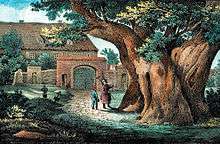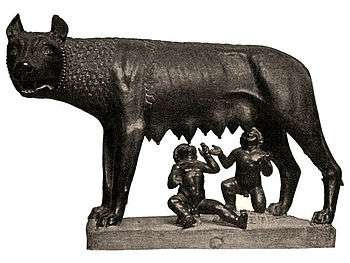Plant epithet

A plant epithet is a name used to label a person or group, by association with some perceived quality of a plant. Vegetable epithets such as turnip may be pejorative, readily giving offence, or positive, typically names of flowers, such as the rose. Flower names such as Hazel, Holly, Jasmine and Rose are commonly given to girls. Tree surnames such as Oak and Ash are toponymic, given to a person in the Middle Ages who lived in a place near a conspicuous tree. A few plant names such as Pease and Onions are metonymic, for sellers of peas and onions respectively. Finally, plant names are sometimes emblematic, as in the name Rose, used as a family emblem.
Vegetable insults
Plant epithets may be pejorative, used humorously and sometimes offensively. Some plant epithets are used directly as insults, as when people are called turnips, potatoes, or cabbages.[2] When the England football team lost to Sweden under Graham Taylor, The Sun newspaper led with the headline "Swedes 2 Turnips 1", swede being a pun on a vegetable, and turnip being an insult.[3] In English the collective term vegetable is also pejorative. Plant epithets are used around the world, but the choice of plants and their meanings vary. Thus in China, "stupid melon" is used as an insult.[2] In Britain, coconut is sometimes used by black people to insult other coloured people; the term indicates betrayal, as coconuts are brown on the outside but white on the inside.[4]
Flower names
In contrast to vegetable epithets, flower names are generally positive. "English rose" has traditionally been used to describe an attractive English woman with a fair complexion. An early documented usage is in Basil Hood's 1902 comic opera Merrie England.[5] Flower names are used in many countries for girls; examples in English include Bryony, Daisy, Iris, Hazel, Heather, Holly, Hyacinth, Jasmine, Lily, Rose, and Violet. Forms of the generic term flower are also popular, including for example Fleur, Flora, Florence and Flores,[6][7] and in other languages Anthea, Blodwen, Kveta, Leilani, and Zahrah.[8] English flower names are less common for boys, but include Hawthorn; in the form of May, the same flower is used as a girl's name.[8] Laurel, for a victor's wreath made of the sweet bay or laurel, with feminine forms such as Laura, is used for both boys and girls.[9]
Plant surnames

People acquired plant surnames in the Middle Ages for different reasons. Toponymic surnames were given to people who lived by a significant feature such as a large isolated tree, a group of trees, or a wood: or, very often, in a village beside such a feature. Metonymic surnames, on the other hand, denoted a person's profession, and include Pease, for a seller of peas,[10] and Onions, for a seller of onions (though some people with that surname got it from the Old Welsh name Enniaum).[11] Other plant metonyms include Plant(e) itself, from 1262, with Plantebene (a grower of beans, 1199) and Planterose (a grower of roses, 1221) as earlier forms.[12][13]
Toponymic surnames include Oak, with variants such as Oake, Oke, Oakes, Noke and Roke since 1273,[14][15] Ash, with variations such as Ashe, Asche, Aish, Esch and Nash since 1221,[16][17] and Birch or Birchwood, since 1182.[18] Hazel is recorded in many toponymic surnames, including Hazel itself from 1182, Hazelwood/Aizlewood, Hazelton, Hazelhurst, Hazelgrove, Hazelden and Heseltine.[19] Surnames such as Hollies and Hollin(g)s, since 1275, mean a person who lived by a holly or holm oak tree.[20] Surnames such as Plumtree, Plumpton, and Plumstead denote people who lived in places by a plum tree or orchard.[21][22] Similarly, Appleby, Appleton, Applegarth and Appleyard name people who lived by an apple orchard, or in villages in Cheshire, Cumbria, Kent and Yorkshire which were named for their apple orchards.[23] Surnames including Apps, Asp, Epps and Hesp record that a person lived by an aspen tree, the letters often being swapped over.[24]

A third source of plant names is their use as emblems, as in the surnames Rose, Royce, and Pluckrose, all meaning a person who used the rose as their family emblem.[25] The English royal Plantagenet dynasty appears to have derived its name from the use of a sprig of broom or planta genista as an emblem. "Plantegenest" (or "Plante Genest") was a 12th-century nickname for Geoffrey Plantagenet, Count of Anjou and duke of Normandy; Richard of York, 3rd Duke of York adopted Plantagenet as his family name in the 15th century, perhaps to emphasise his status as a patrilineal descendant of Geoffrey.[26][27]
Plant surnames are found in other languages. For example, in Sweden, where "Lind" means the Lime or Linden tree, the 100 most common surnames in 2015 included at 17 Lindberg (Lime-hill), at 21 Lindström (Lime-stream), at 22 Lindqvist (Lime-twig), at 23 Lindgren (Lime-branch), and at 99 Lindholm (Lime-island). Other tree names in the top 100 were 46 Björk (Birch), 56 Löfgren (Leaf-branch), 66 Björklund (Birchwood), 77 Ekström (Oak-stream), 79 Hedlund (Heathwood) and 87 Ek (Oak).[28] Many of these names are toponymic.[29] From around 1686, Swedish soldiers started to adopt military surnames; short monosyllabic tree-names like Al (Alder), Alm (Elm) and Ek (Oak) were popular.[30]
In France, the surnames Laplante (The plant) and Levigne (The vine) denote the owner of a vineyard, or may be toponymic.[31][32] Tree names also occur in France, where for example the surname Chene (Oak) is not uncommon in Loire-Atlantique and Maine-et-Loire.[33]
See also
References
- ↑ "Gemma Arterton, an English Rose at Cannes". www.celebrityredcarpet.co.uk/. Retrieved 29 July 2014.
Amongst ~45.3k results for "English rose" "Gemma Arterton"
- 1 2 Dunlop, Fuchsia. "You turnip! Vegetable insults around the world". Retrieved 25 July 2016.
- ↑ Edworthy, Niall (1997). England: The Official F.A History. Virgin. p. 149. ISBN 1-85227-699-1.
- ↑ Grice, Elizabeth (30 June 2010). "Was it necessary to turn an insult involving coconuts into a criminal prosecution?". Daily Telegraph. Retrieved 25 July 2016.
- ↑ Dent, edited by Susie (2012). Brewer's dictionary of phrase & fable (19th ed.). Chambers. p. 445. ISBN 978-0-550-10245-4.
- ↑ "Flower Names for Girls and Boys". Retrieved 25 July 2016.
- ↑ "Girl Flower Names". Retrieved 25 July 2016.
- 1 2 "May Names". British Baby Names. Retrieved 25 July 2016.
- ↑ "Laurel". Retrieved 27 July 2016.
- ↑ Reaney, page 343
- ↑ Reaney, page 330
- ↑ "Last Name: Plant". The Internet Surname Database. Retrieved 25 July 2016.
- ↑ Reaney, page 354
- ↑ "Last name: Oak". The Internet Surname Database. Retrieved 25 July 2016.
- ↑ Reaney, page 327
- ↑ "Last Name: Ash". The Internet Surname Database. Retrieved 25 July 2016.
- ↑ Reaney, page 15
- ↑ Reaney, page 45
- ↑ Reaney, pages 223–224
- ↑ Reaney, pages 235–236
- ↑ Reaney, page 355
- ↑ Mills, page 260
- ↑ Reaney, pages 12–13
- ↑ Reaney, page 13
- ↑ Reaney, page 383
- ↑ Plant, John S. (2007). "The Tardy Adoption of the Plantagenet Surname". Nomina. 30: 57–84. ISSN 0141-6340.
- ↑ Wagner, John (2001). Encyclopedia of the Wars of the Roses. ABC-CLIO. p. 206. ISBN 1-85109-358-3.
- ↑ "Efternamn, topp 100 (2015)" (in Swedish). Statistiska centralbyrån (Statistics Sweden). 22 February 2016. Retrieved 26 July 2016.
- ↑ Bergman, Gösta (1988). Kortfattad svensk språkhistoria (in Swedish). Prisma. pp. 217–.
- ↑ Högman, Hans (23 February 2016). "Svenskt namnskick i gångna tider". Retrieved 26 July 2016.
- ↑ "Patronyme Laplante : Nom de famille" (in French). Genealogie.com. Retrieved 27 July 2016.
- ↑ "Patronyme Levigne : Nom de famille" (in French). Genealogie.com. Retrieved 27 July 2016.
- ↑ "Tout savoir sur le nom Chene". Genealogie.com. Retrieved 27 July 2016.
Sources
- Mills, A. D. (1993). A Dictionary of English Place-Names. Oxford University Press. ISBN 0-192-83131-3.
- Reaney, P. H.; Wilson, R. M. (1997). A Dictionary of English Surnames. Oxford University Press. ISBN 0-198-60092-5.

